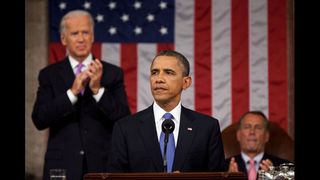Executive Privilege: Presidents Outlive Their Contemporaries

When presidents start to sprout gray hairs and look a little wrinkly around re-election time, people often blame the stresses of holding the office for causing accelerated aging. But a new study finds that the presidency isn't so hard on elected officials after all; in fact, presidents are likely to live longer than men born in the same year as them.
Additionally, 23 of 34 U.S. presidents who have died of natural causes lived well beyond what would have been expected if they were aging twice as fast while president, as some doctors have asserted, said study researcher S. Jay Olshansky, a professor of public health at the University of Illinois at Chicago. Most likely, Olshansky said, the privilege of wealth, education and medical access lengthened these men's life spans.
"To me, it's a classic illustration of the benefits of socioeconomic status," Olshansky told LiveScience. "All but 10 of the presidents were college-educated, they were all wealthy, and they all had access to medical care."
Stress and aging
Olshansky, who researches health and longevity, became interested in the question of presidential aging when President Barack Obama turned 50 in August 2011. News reports were rife with pictures of the graying president next to snapshots from inauguration day, Olshansky said, and some doctors and psychologists told reporters that the stress of the job was aging Obama prematurely.
In fact, there is disagreement among experts whether presidential stress, or any stress, strongly affects the color of your tresses. Genetics plays a major role in graying hair, and most presidents are of an age when graying hair and wrinkling skin are common.
No one dies of wrinkles and gray hair, Olshansky said, but if presidents really age at double-speed during office, it should show in their longevity: For every day they sit as president, their life spans should be cut short by two days. [Top 10 Ailing Presidents]
Sign up for the Live Science daily newsletter now
Get the world’s most fascinating discoveries delivered straight to your inbox.
As presidential birth, inauguration and death dates tend to be well-recorded, Olshansky had all the data he needed to see if presidents suffer from truncated life spans. He compared the life expectancies of all presidents who have died of natural causes with the life expectancies of same-age contemporaries, using data from the Social Security Administration and the Human Mortality Database. (Presidents who died by assassination were excluded, as their deaths were unrelated to aging.) For the 1800s, Olshansky used life expectancy data from France, because the U.S. did not keep reliable population records during that time.
Healthy living
The results revealed that presidents were no more likely to die young than men who were the same age on Inauguration Day. The average estimated life span of the average age-matched man between 1789 and the present was 73.3 years, Olshansky reports in the Dec. 7 issue of the Journal of the American Medical Association. The 34 presidents lived to an average age of 73 years.
On the whole, Olshansky added, presidents had already won the life-span lottery by the time they were inaugurated. The average age of inauguration was about 55, and many male babies born on the same date as the presidents wouldn't have made it that far, especially early in the country's history. For example, Olshansky said, the average life span of the first eight presidents, from George Washington to Martin Van Buren, was 79.8 years. The life expectancy for the average man born in those presidents' birth years was under 40.
Once inaugurated, the presidents showed no evidence of a shortened life span compared with other men who had likewise survived the perilous years of youth. If presidents did, in fact, age at twice the normal rate while in office, their expected average life span would have been 68.1 years, Olshansky found. If that number were accurate, he said, you'd expect to see half of the presidents die before age 68 and the other half after. In reality, two-thirds of the presidents outlived that estimate.
Olshansky's study doesn't answer the question of whether presidents show the outward signs of aging faster than the average Joe, but he said most seem to be undergoing a perfectly natural process.
"If you take a picture of anyone in their mid-to-late 50s and then take a picture four to eight years later, they're all going to experience outward signs of aging," he said. "Presidents are just experiencing the same thing everyone else is experiencing. You know, join the club."
Either way, he said, his study reveals that presidents are relatively youthful where it counts.
"The outward signs of aging don't necessarily tell us much about the inward signs of aging," Olshansky said. "These individuals do, in fact, mostly live longer than you would have predicted."
You can follow LiveScience senior writer Stephanie Pappas on Twitter @sipappas. Follow LiveScience for the latest in science news and discoveries on Twitter @livescience and on Facebook.

Stephanie Pappas is a contributing writer for Live Science, covering topics ranging from geoscience to archaeology to the human brain and behavior. She was previously a senior writer for Live Science but is now a freelancer based in Denver, Colorado, and regularly contributes to Scientific American and The Monitor, the monthly magazine of the American Psychological Association. Stephanie received a bachelor's degree in psychology from the University of South Carolina and a graduate certificate in science communication from the University of California, Santa Cruz.